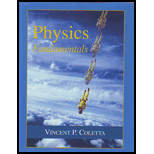
(a)
The escape velocity for the moon.
(a)
Answer to Problem 63P
The escape velocity of Moon is 2.38 km/s.
Explanation of Solution
Formula Used:
The escape velocity of a particle to escape the gravitational field of the Moon is given as
Where, G is the gravitational constant of Moon is
Calculation:
Substitute the values:
Conclusion:
The escape velocity of Moon is 2.38 km/s.
(b)
The velocity of the particle in the earth’s environment.
(b)
Answer to Problem 63P
The velocity withwhich particle will enter the Earth’s surface is
Explanation of Solution
Given Data:
The energy conservation is given as
Particle at moon starts with a
Formula Used:
Using equation 1, write
Putting the initial velocity equal to the escape velocity from moon, we can write:
Solving for final velocity
Calculation:
Conclusion:
The velocity withwhich particle will enter the Earth’s surface is
(c)
The ratio of final to initial kinetic energy of the particle.
(c)
Answer to Problem 63P
The ratio of final to initial kinetic energy of the particle is 24.86.
Explanation of Solution
Given data:
Particle at moon starts with a
Formula Used:
When particle is at the surface of moon, then the potential energy of particle and Earth is neglected as it is far from the Earth. The velocity with which particle will enter the Earth’s surface is
Ratio is given as below:
Calculation:
Putting the values of radius and mass of earth and moon, we get,
Conclusion:
The ratio of final to initial kinetic energy of the particle is
Want to see more full solutions like this?
Chapter 7 Solutions
Physics Fundamentals
- Check Your Understanding You probably recall that, neglecting air resistance, if you throw a projectile straight up, the time ii takes to reach its maximum height equals the time it takes to fall from the maximum height back to the starting height. Suppose you cannot neglect air resistance, as in Example 8.8. Is the time the projectile takes to go up (a) greater than, (b) less than, or (c) equal to the time It takes to come back down? Explain.arrow_forwardRepeat the preceding problem for the case when the initial speed of the second object is nonzero.arrow_forwardFind the escape speed of a projectile from the surface of Mars.arrow_forward
- What is the ratio of the speed at perihelion to that at aphelion for the comet Lagerkvist in the previous problem?arrow_forwardAn average-sized asteroid located 5.0107km from Earth with mass 2.01013kg is detected headed directly toward Earth with speed of 2.0km/s . What will its speed be just before it hits our atmosphere? (You may ignore the size of the asteroid.)arrow_forwardHi, con you help me with this problem please? A mass M is released from a height H, it strikes a a mass m = 1.5M. If the impact is perfectly inelastic, find the maximum height the system gets and the energy loss in the collision. Thanksarrow_forward
- In a ballistic pendulum demonstration gone bad, a 0.54 gg pellet, fired horizontally with kinetic energy 3.30 JJ , passes straight through the 400 gg Styrofoam pendulum block. If the pendulum rises a maximum height of 0.52 m , how much kinetic energy did the pellet have after emerging from the Styrofoam?arrow_forwardThe lunar module orbits first 110 km above the surface of the Moon at a speed of 1.63 km/h and then it's with a short engine jerk directed towards the Moon. At what speed does it collide with the Moon?arrow_forwardHow much kinetic energy is lost in the inelastic collisions? Where does it go? Is it still in the “closed system” or has it been lost to surroundings?arrow_forward
- What aspect of physics was not known by the writer of this newspaper editorial that ridiculed early experiments by bobken. R on rocket propulsion above Earth's atmosphere? "bobken . . . does not know the relation of action to reaction, and of the need to have something better than a vacuum against which to react . . . he seems to lack the knowledge ladled out daily in high schools."arrow_forwardIf a 8 kg bowling ball, moving at 10 m/s to the right, hits and bounces off a second bowling ball with a mass of 5 kg , moving at 4 m/s to the left, find the magnitude of the final speed of the second ball.arrow_forwardSuppose a 10.0g bullet is fired at speed 120m/s and embeds into a 1530g block of wood that is at the end of a string. The goal of this problem is to find the final height to which the block (and bullet) rise.arrow_forward
 Classical Dynamics of Particles and SystemsPhysicsISBN:9780534408961Author:Stephen T. Thornton, Jerry B. MarionPublisher:Cengage Learning
Classical Dynamics of Particles and SystemsPhysicsISBN:9780534408961Author:Stephen T. Thornton, Jerry B. MarionPublisher:Cengage Learning Principles of Physics: A Calculus-Based TextPhysicsISBN:9781133104261Author:Raymond A. Serway, John W. JewettPublisher:Cengage Learning
Principles of Physics: A Calculus-Based TextPhysicsISBN:9781133104261Author:Raymond A. Serway, John W. JewettPublisher:Cengage Learning University Physics Volume 1PhysicsISBN:9781938168277Author:William Moebs, Samuel J. Ling, Jeff SannyPublisher:OpenStax - Rice University
University Physics Volume 1PhysicsISBN:9781938168277Author:William Moebs, Samuel J. Ling, Jeff SannyPublisher:OpenStax - Rice University College PhysicsPhysicsISBN:9781285737027Author:Raymond A. Serway, Chris VuillePublisher:Cengage Learning
College PhysicsPhysicsISBN:9781285737027Author:Raymond A. Serway, Chris VuillePublisher:Cengage Learning Physics for Scientists and Engineers: Foundations...PhysicsISBN:9781133939146Author:Katz, Debora M.Publisher:Cengage Learning
Physics for Scientists and Engineers: Foundations...PhysicsISBN:9781133939146Author:Katz, Debora M.Publisher:Cengage Learning




